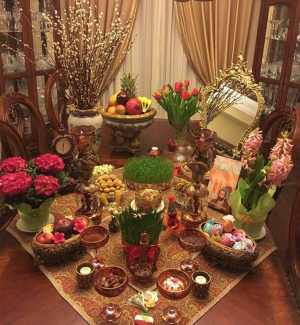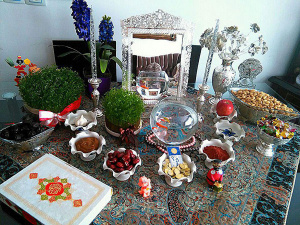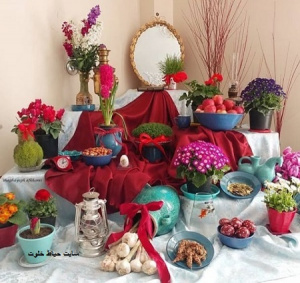Difference between revisions of "Language/Iranian-persian/Culture/Haft-sin"
m (add picture) |
|||
| Line 1: | Line 1: | ||
[[File:هفت سین.jpg|thumb]] | [[File:هفت سین.jpg|thumb]] | ||
[[File:هفت-سین-96-9.jpg|thumb]] | |||
[[File:Sofre7sin.jpg|thumb]] | |||
<div style="font-size:300%;">Haft-sin</div> | |||
Haft-sin or Haft-seen (Persian: هفتسین) is a traditional custom in the Persian New Year holiday. | |||
==Primary items== | ==Primary items== | ||
| Line 14: | Line 15: | ||
# ''Senjed'' (سنجد) – Persian olive. | # ''Senjed'' (سنجد) – Persian olive. | ||
# ''Serkeh'' (سرکه) – vinegar. | # ''Serkeh'' (سرکه) – vinegar. | ||
# | #''Seeb'' (سیب) – apple. | ||
# ''Seer'' (سیر) – garlic. | # ''Seer'' (سیر) – garlic. | ||
# ''Somāq'' (سماق) – sumac. | # ''Somāq'' (سماق) – sumac. | ||
Revision as of 07:59, 25 April 2020
Haft-sin or Haft-seen (Persian: هفتسین) is a traditional custom in the Persian New Year holiday.
Primary items
The following are the primary 7 items of Haft-sin, whose Persian names begin with the letter "س" in the Persian alphabet (pronounced as "seen").
- Sabzeh (سبزه) – wheat, barley, mung bean, or lentil sprouts grown in a dish.
- Samanu (سمنو) – wheat germ sweet pudding.
- Senjed (سنجد) – Persian olive.
- Serkeh (سرکه) – vinegar.
- Seeb (سیب) – apple.
- Seer (سیر) – garlic.
- Somāq (سماق) – sumac.
SenjedSonbolSomāq
Coins (سکه sekke), hyacinth (سنبل sonbol), and clock (ساعت saat) are sometimes included too. Other symbolic items that are typically used to accompany Haft-sin include a mirror, candles, painted eggs, goldfish, and traditional Persian confectioneries.
A "book of wisdom" is also commonly included, which might be the Quran, the Bible, the Avesta, the Shahnameh, or the divān of Hafez
The Haft-Seen table represents nature. By tradition, Iranian families take great pains to create the most beautiful Haft-Seen table that they can, for not only does it embody values both traditional and spiritual, it is also appreciated by the visitors during Nowruz visiting exchanges as a reflection of the families' aesthetic sense and good taste.
Items starting with the Persian letter "س":
- Sabzeh (سبزه): the symbol of rebirth and growth.
- Samanu (سمنو): the symbol of power and strength.
- Senjed (سنجد): the symbol of love.
- Somāq (سماق): the symbol of sunrise.
- Serkeh (سرکه): the symbol of patience.
- Seeb (سیب): the symbol of beauty.
- Seer (سیر): the symbol of health and medicine.
Other items starting with the Persian letter "س" are sometimes included:
- Sonbol (سنبل): the symbol of spring's arrival.
- Sekkeh (سکه): the symbol of wealth and prosperity.
- Saat (ساعت): the symbol of time.
Items not starting with "س" but, nonetheless, invariably included:
- eggs (تخممرغ رنگی): the symbol of fertility.
- mirror (آینه): the symbol of self-reflection.
- candle (شمع): the symbol of enlightenment.
- goldfish (ماهی قرمز): the symbol of progress.
- book (کتاب): the symbol of wisdom.


